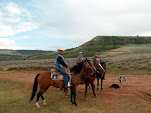 |
| The same chickens next to a Buff Orphington Hen who is normal sized so you can see just how small they are. |
 |
| Highlander cattle are a scottish breed and a good many of the farms seemed to have them. I suspect because the Maine winters were much easier for the Highlanders to thrive in. |
 |
| A black Highlander calf with a bell |
 |
| The view from where the Highlander cattle's pasture was located. I think the Red tree is a sugar maple. |
 |
| A Highlander family - Bull, calf and cow. |
 |
| A duck - I have no idea what breed but certainly something we don't find in Wyoming. |
 |
| A pair of ponies with some ducks. Neither of these were Minnie's parents. Both of the ponies were broke to drive. |
 |
| The ducks and chickens with two dwarf goats in the back. |
 |
| A regular sized dairy goat. I was quite smitten with her and could have taken her home but I suspect Delta airlines would have objected to the new passenger. |
 |
| A 1800's Maine farmhouse. These were all over Maine and they are one long continuous building, house, wood shed, tool shed, and barn. This one is unusual in that it still has the silo standing. |
 |
| The front of the same Maine Farmhouse |
Next post will be Bar Harbor and Acadia National Park.






I've heard of attached farm buildings, but these are the first photos I've seen on one.
ReplyDeleteYes, very interesting. I, too, had heard of farm buildings that were all attached, but did not realize there were a lot of them. Sounded very practical to me -- but then I had not considered that fire in one building would take everything. Thanks for all the pictures. Minnie is going to be one spoiled little pony. She'll have to have her very own bedroom.
ReplyDeleteI had never heard of attched farm buildings. This was very interesting. Love the little foal and the scottish cattle. Great pictures.
ReplyDelete